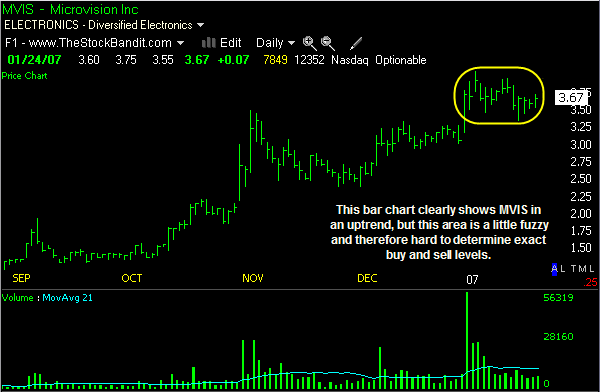When To Use Line Charts
Most of us use bar charts or candlestick charts, but you don’t see a lot of line charts these days. The reason why is that a line chart is generally drawn using only the closing level of a stock, so it paints the end result and leaves out a lot of the “noise” along the way.
Line charts do have their place in trading, and I’ll give you a good example of a time when I use them. I look through a ton of charts every night, and you might too. What you find when you do that is that you’ll run across stocks which just give you the feeling that they’re about to move a certain way. Typically, I’ll draw trend lines and look for well-defined chart patterns to provide entry and exit levels for new trades. However, some charts just aren’t clean enough to do that effectively, so I’ll switch over from a bar chart to a line chart.
Let’s look at an example of this.
MVIS is in an uptrend, and one look at this bar chart does show higher lows along the way. The problem is, the past 15 bars or so are in sort of a messy area, making it hard to determine a precise entry and exit level without giving the stock too much room. (Click the chart below for full size)
So MVIS looks good for some upside, but we can’t find an exact entry. Switch over to a line chart format and it’s amazing how much cleaner the stock looks now. We have a nice base here with this descending channel pattern, giving us a well-defined entry level and exit level (above and below the channel, respectively). (Click the chart below for full size)
The next time you have that gut feel that a stock might be gearing up for a move but you can’t pick a good spot to structure your trade, try a line chart. You’ll find the levels will often be much cleaner, and you’ll trade more effectively because of it.
Jeff White
President, The Stock Bandit, Inc.
www.TheStockBandit.com








